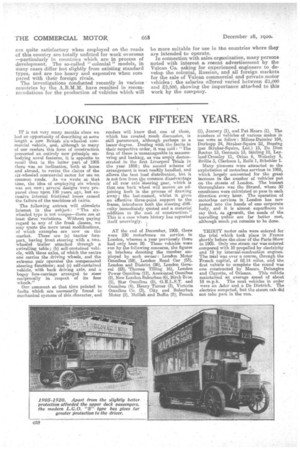LOOKING BACK FIFTEEN YEARS.
Page 24

If you've noticed an error in this article please click here to report it so we can fix it.
IT is not very many months since we had an opportunity of describing at some length a new British six-wheeled commercial vehicle, and, although to many of our readers this form of construction presented an entirely new principle embodying novel features, it is apposite to recall that in the latter part of 1905 there was a,n inclination, both at home and abroad, to revive the claims of the six-wheeled: commercial meter for use on common roads. As we wrote at that time, the idea of employing six wheels was not new ; several designs were prepared close upon 100 years ago, but excessive internal frictional losses caused the failure of the machines ab initio.
The following extract will stimulate interest in . the subject: 'The sixwheeled type is not unique-there are at least three variatione. Without paying regard to any of the freak classes, we may quote the more usual modifications, of which examples are now on the market. These are (a) tractor forepart, having front steering with a two
wheeled trailer attached through a swivelling table; (b) self-contained vehicle, with three a,xles, of which the centre one carries the driving wheels, and the extreme pair operator; the compensated steering functions; and (e) self-contained vehicle, with back driving axle, and a bogey fore-carriage arranged to steer reciprocally in respect of its four wheels."
Our comment at that time pointed to faults which are necessarily found in mechanical systems of this character, and
readers will know that one of them, which has created much discussion is still paramount, although perhaps to a lesser degree. Dealing with the faults in their respective order, it was said "The first of these is unmanageable in manceuwing and backing, as was amply demonstrated in the first Liverpool Trials in the year 1898; the second scheme of arrangement is most readily handled, and allows the best load distribution, but it is not free from fie common disadvantage of all rear axle steering gear, which is that one back wheel will mount an adjoining kerb in the process of drawing away ; the last-named, whilst it gives an effective three-point support to the frame, introduces both the steering difficulty immediately quoted and a material addition to the cost of construction." This is a ease Where history has repeated itself unerringly. , AT the end of December, 1905. there were 230 motorbuses on service in London, whereas a year previously there had only been 20. These vehicles were rim by the following concerns, the figures in brackets denoting the number employed by each owner : London Motor Omiiiibus (58), London Road Car (53), London and District (26), London Gene. rim! (23), Thomas Tilling 16), London Power Omnibus (12), Associated Omnibus (9), New Landon Suburban (6), Birch Bros. (5), Star Omnibus (5), G.R.L.S.2'. and Omnibus (4), Henry Turner (3), Victoria Omnibus Co. (3), City and Suburban Motor (2), Mellish and Boffin (2); French (1), Jennery (1), and Pat Hearn (1). The numbers of vehicles of various makes in use were as follow : Milnes-Daimler 104, Durkopp 24, Straker-Squire 22, Bussing (per Straker-Squire, Ltd.) 15, De Dion Benton 13, Germain 13, Stirling 12, Leyland-Crossley 11, Orion, 6, Wolseley 4, Brillie 3, Clarkson 1, Rolls 1, Schebier 1.
Many pioneers were attracted to the exploitation of motorbus services in 1905, which largely accounted for the great increase in the number of vehicles put on the streets of London. The busiest thoroughfare was the Strand, where 50 omnibuses were calculated to pass in each direction every hour. The operation of motorbus services in London has now passed into the hands of one corporate body, and it is almost superfluous to say that, as eeresult, the needs of the travelling public are far better met, although much yet remains to be done.
THIRTY motor cabs were entered for the trial which took place in France shortly before the close of the Paris Show in 1905. Only one steam car was entered compared with 10 propelled by electricity and 19 by internal-combustion engines. The trial was over a course, through the French capital, of 62.14 miles, and the first vehicle to complete the round was one constructed by Messrs. Delaugere and Clayette, of Orleans. This vehicle maintained an average speed of about 18 m.p.h. The next vehicles in order were an Ader and a De Dietrich. The electrics competed, but the steam cab did not take part in the run.






























